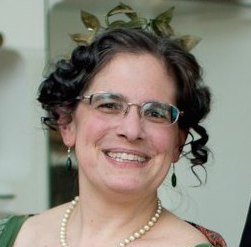The American Gavotte is another of the variations published by dancing master M. B. Gilbert in his manual of couple dances, Round Dancing (Portland, Maine, 1890) and republished by G. W. Lopp in La Danse (Paris, 1903). It was attributed by Gilbert to James P. Brooks of Pittsburgh, Pennsylvania (and by Lopp to “J.-D. Brooks”). Gilbert also noted that it was adopted by the American Society of Professors of Dancing, New York — this would have been in 1886, from contemporary writeups of the event — and published by permission of White Smith Music Publishing Co. Lopp listed it as “Polka Américaine (American Gavotte)”
I’ve discussed a couple of other American “gavotte” variations before, but both of those were for the schottische. The American Gavotte is listed as a polka, though it actually works perfectly well to schottische music and there is some confusion surround how it is notated that suggests that it might have originally been meant as a schottische; see the music note below. It certainly has some choreographic kinship with the schottische gavottes in that it also uses the rhythm pattern “1&2&3,4” stepped as “slide, chassé, chassé, close” or “slide-close-slide-close-slide, close”. This is one measure of schottische as usually counted, but two measures of polka. Because of the pattern of the following four beats of music, I actually prefer to break the first four up into two bars, polka style, as follows, with dancers starting on their first foot (his left, her right):
1b Slide-close-slide-close (galop) (1&2&)
1b Slide-close (3,4)
1b Slide-close (1,2)
1b Slide-close-slide (galop half-turn) (3&4)
4b Repeat all of the above starting on second foot and “over elbows”
I find it’s easiest to think of the second and third bars as the same “slide-close” steps rather than merging the first and second bars into one four-count sliding sequence as Gilbert notated it. Lopp apparently agreed with me; he listed it as four bars of 2/4 repeated rather than two bars of 4/4 repeated. Other than the confusion about how to notate the bars, the reconstruction is utterly straightforward.
This is a perfectly pleasant little variation; it’s not particularly distinctive, but it’s easy to dance and easy to lead. Its adoption by the American Society of Professors of Dancing gave it some mild notoriety:
America boasts a society of professors of dancing. The members thereof have agreed to introduce three new dances invented by the society. Two are round dances named the ‘Columbia’ and the ‘American Gavotte’ and one is a square dance called the ‘Octagon,’ which is danced by eight couples, and is somewhat like the lancers. It is almost time something novel was introduced in New Zealand ballrooms. The eternal valse is too, too utterly tame and monotonous, the only variety achievable being in the eccentricity of step exhibited by some of the dancers. Do you agree with me?
— excerpted from “Chit Chat”, The New Zealand Mail, Friday, May 20th, 1887, p. 4
An American writeup offers a little more detail, though they don’t seem to have the dance quite right (what hop?) and add more confusion schottische/polka issue:
The American Gavotte will be danced to gavotte or 4-4 time. It is very easy to learn, the professors say. It is smoother than the ordinary dances, and starts with a movement sideways, then a turn and a hop and a polka, and a slide afterward. It is slower than a waltz. However, as Mr. Secretary Rivers said to the reporter, it is quite difficult to describe a dance orally so that you can learn the step. Prof. Brookes [sic] introduced this dance.
— excerpted from the Columbus Enquirer-Sun, September 12, 1886
Music Note
Given that this was published by permission of a major music publisher (White Smith), I think it’s safe to say there was a specific piece of music that it was matched to, and possibly the dance instructions were originally published on that sheet music. Unfortunately, I haven’t been able to locate a copy of it.
As noted above, I am mildly suspicious about Gilbert’s having listed it as a polka; it would make just as much sense as a schottische (as most “gavotte” dances are categorized), and both Gilbert’s writeup and the Columbus Enquirer-Sun blurb suggest that it was notated in four. I suspect that Gilbert may have made an error in assigning it to the polkas. On the other hand, Lopp seemed pretty clear that it was a polka, notating it in 2/4 and listing the desired tempo has 116 beats per minute. Locating the original sheet music would help resolve this issue, and I hope to do so eventually. In the meantime, happily, the American Gavotte works with both polka and schottische music!


Leave a Reply